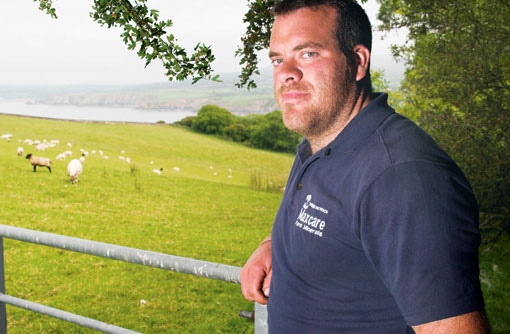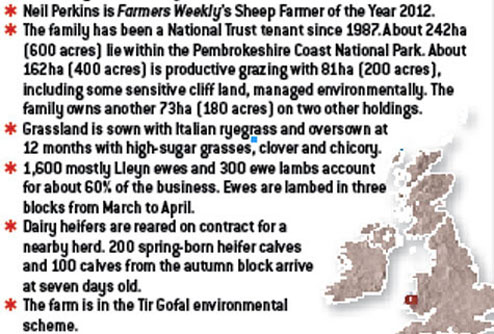Rotational grazing sheep reap rewards in Wales

Instead of set-stocking their ewes and lambs, the Perkins family allows grass leys to recover and be utilised by rotationally grazing paddocks.
Although this system requires some additional labour, the results have been exceptional. Under the previous set-stocking system, only 60% of the grass was utilised, but this has increased by over 30%.
“We have reached a point where we are asking ourselves: do we totally cut out bagged nitrogen or do we increase our stocking rate to make use of the grass,” Neil says.
At 20 units an acre, nitrogen inputs are already low, but there is the potential to cut costs even further, or to increase output.
“Previously, we had been buying in silage but now we are getting more from the grass, and the stocking rate hasn’t changed,” Neil adds.
“If we manage the excess we don’t lose quality in the spring and it allows us to build a surplus for the autumn. This extends our winter because we have more forage to hold the ewes. This system is buying us another six weeks without housing.”

A system tried and tested
Neil had seen a similar grazing technique in New Zealand six-years ago, but his focus at that time was on establishing his breeding flock.
Investment was also needed in the infrastructure. This cost the business in excess of £10,000 but, now in its second year, it has already paid for itself.
There are ten 24-acre fields, which form part of Dinas Island Farm, each divided into two with sheep wire and two water troughs in the centre of the field serving both halves.
This restricts pressure on the fields when animals are turned out at a rapid rate after lambing, and reduces incidences of mismothering.
Sixty sheep are allocated to each half, equivalent to a stocking rate of 5 ewes/acre.
When the first lambs reach 6-8 weeks, the mobs from both halves of each field are taken inside to be dosed and amalgamated to form one group.
The group of 120 is returned to one half of the field when grass starts to grow, which is maintained at a height of 4-6cm in both halves.
After between seven and 10 days, a three-strand electric fence is run through the middle of the field to create four quarters.
All 120 animals graze each six-acre quarter down to 4cm before they are moved into the next quarter where the grass is now at 6-8cm.
Two creep hurdles are positioned next to the water troughs to allow lambs to forward graze the best grass. The position of the hurdles is altered with the rotation.
When the grass in any quarter gets ahead of the mob, the Perkins initially turn a flying mob of singles into it and, when these are unable to keep on top of growth, grass is cut to be made into haylage.
“Because we harvest it as soon as the grass is long enough, the sward underneath is green, not yellow as it would be if the grass was too long. It recovers well from this position,” Neil says.
The mob remains as one unit until weaning, when they are amalgamated to form groups of 400-500 lambs and grouped according to weight. Lighter lambs are held on outlying land.
Groups of 500 heavy lambs run through all the quarters, not just in a single field, again ahead of the ewes to get the best of the grazing.
“We rotate 40 quarters with the ewes tidying up after the lambs,” Neil adds. As the heavier lambs are sold they are replaced by the lighter lambs. A mob of 1,000 ewes acts as a topper, controlling the grass at the peak of its growth in any paddocks where production exceeds use.
In October, any unsold lambs graze off-lying red clover leys, which allows all 10 fields to be allocated to the ewes at tupping.
The ewes are grouped with rams into the quarter-field paddocks, but stocked at just 100 animals a paddock because grass production starts to diminish.
The groups rotate around the paddocks until the rams have been with the ewes for four weeks. All 1,400 ewes are then amalgamated into one group to graze a six-acre block, creating a stocking rate of 200 ewes/acre. Over a 40-day period, each quarter is grazed for one day.
This extends grazing at the end of the year and reduces poaching. Also, because the ewes are in the second third of their pregnancies, it gives control over their intakes.
“All I have to do is open the gate once a day and the ewes run straight through because by then they are ready for their next feed,” Neil says.
“It is good grass and they just stand there and eat it. It disappears after five or six hours and the ewes then just sit down because their bellies are full.”
The land also recovers better than it would if the ewes had been set-stocked, he adds. “Within three weeks the sward is green again and that is how it is held until turnout.”
Measuring the benefits
To complement the system, the Perkins have created a system of livestock units to enable the production of each field to be compared.
Each lamb is allocated a stock unit based on live weights and ewes according to their time of year – whether they are dry, pregnant or lactating.
These figures are listed weekly in an Excel spreadsheet, which calculates how much dry matter is utilised an acre.
“If we had to bring a group of singles into a field that was getting away from us that would be included in the stocking rate and if we had to take bales off that would also be recorded,” Neil says.
The system flags up poor performing fields that need attention and the results aren’t always as might be expected.
“There are fields with older leys that have outperformed those with four-year-old leys,” Neil says. “They might not need reseeding, it might just be a case of aerating the soil.”
Neil is contemplating investing in a quad bike-fitted GPS facility for measuring grass to build up a clearer picture of grass production and utilisation.
The extreme cold weather did challenge grass growth this spring but Dinas Island Farm fared better than many parts of the country.
The grass measured 6cm at turnout however, because of the slow season, it didn’t grow for a month.
“The paddocks dipped below the 4cm minimum so we supplemented with energy blocks. It was enough to keep the condition on the ewes.
“The lambs were fine because the ewes were in good condition going into lambing and they could milk off their backs,” Neil says
The grass started growing well in the last week of April.
Lamb finishing brings challenges
